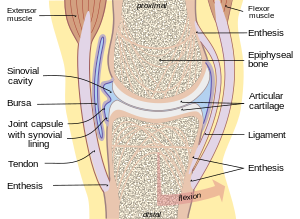| Joint | |
|---|---|
 Diagram of a typical synovial joint | |
 Depiction of an intervertebral disc, a cartilaginous joint | |
| Details | |
| System | Musculoskeletal system Articular system |
| Identifiers | |
| Latin | articulus, junctura, articulatio |
| MeSH | D007596 |
| TA98 | A03.0.00.000 |
| TA2 | 1515 |
| FMA | 7490 |
| Anatomical terminology | |
A joint or articulation (or articular surface) is the connection made between bones, ossicles, or other hard structures in the body which link an animal's skeletal system into a functional whole.[1][2][3] They are constructed to allow for different degrees and types of movement. Some joints, such as the knee, elbow, and shoulder, are self-lubricating, almost frictionless, and are able to withstand compression and maintain heavy loads while still executing smooth and precise movements.[3] Other joints such as sutures between the bones of the skull permit very little movement (only during birth) in order to protect the brain and the sense organs.[3] The connection between a tooth and the jawbone is also called a joint, and is described as a fibrous joint known as a gomphosis. Joints are classified both structurally and functionally.[4]
Joints play a vital role in the human body, contributing to movement, stability, and overall function. They are essential for mobility and flexibility, connecting bones and facilitating a wide range of motions, from simple bending and stretching to complex actions like running and jumping. Beyond enabling movement, joints provide structural support and stability to the skeleton, helping to maintain posture, balance, and the ability to bear weight during daily activities.
The clinical significance of joints is highlighted by common disorders that affect their health and function. Osteoarthritis, a degenerative joint disease, involves the breakdown of cartilage, leading to pain, stiffness, and reduced mobility. Rheumatoid arthritis, an autoimmune disorder, causes chronic inflammation in the joints, often resulting in swelling, pain, and potential deformity. Another prevalent condition, gout, arises from the accumulation of uric acid crystals in the joints, triggering severe pain and inflammation.
Joints also hold diagnostic importance, as their condition can indicate underlying health issues. Symptoms such as joint pain and swelling may signal inflammatory diseases, infections, or metabolic disorders. Effective treatment and management of joint-related conditions often require a multifaceted approach, including physical therapy, medications, lifestyle changes, and, in severe cases, surgical interventions. Preventive care, such as regular exercise, a balanced diet, and avoiding excessive strain, is critical for maintaining joint health, preventing disorders, and improving overall quality of life.
- ^ Whiting, William Charles; Rugg, Stuart (2006). Dynamic Human Anatomy. Vol. 10. Human Kinetics. p. 40. ISBN 9780736036825.
- ^ "Articulation definition". eMedicine Dictionary. 30 October 2013. Archived from the original on 31 July 2012. Retrieved 18 November 2013.
- ^ a b c Saladin, Ken. Anatomy & Physiology. 7th ed. McGraw-Hill Connect. Web. p.274
- ^ Standring, Susan (2006). Gray's anatomy : the anatomical basis of clinical practice (39th ed.). Edinburgh: Elsevier Churchill Livingstone. p. 38. ISBN 0-443-07168-3.